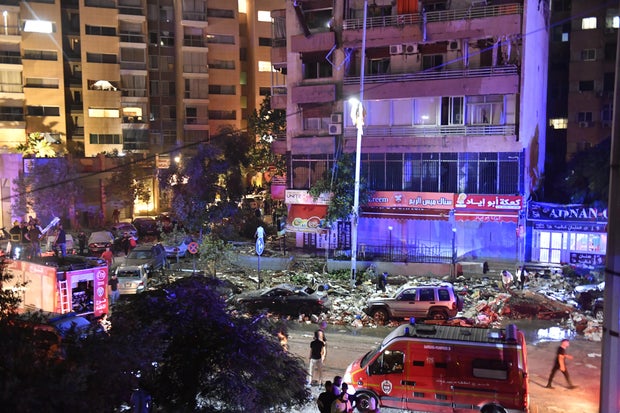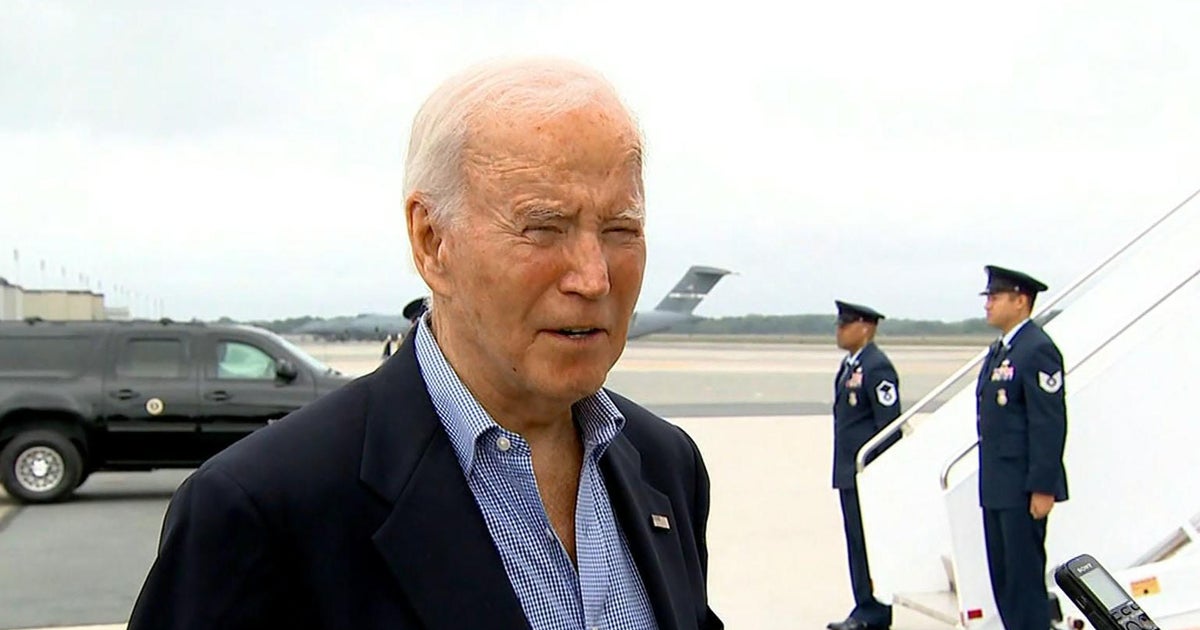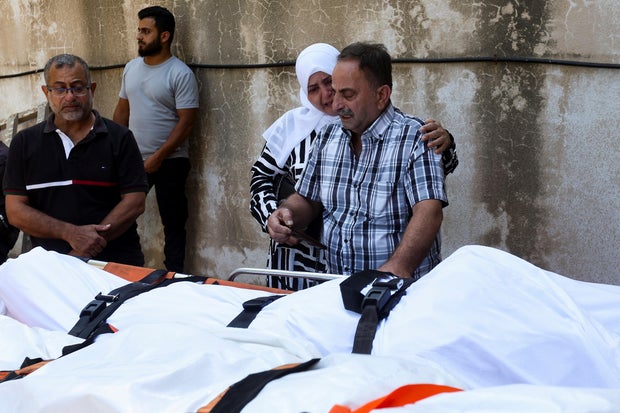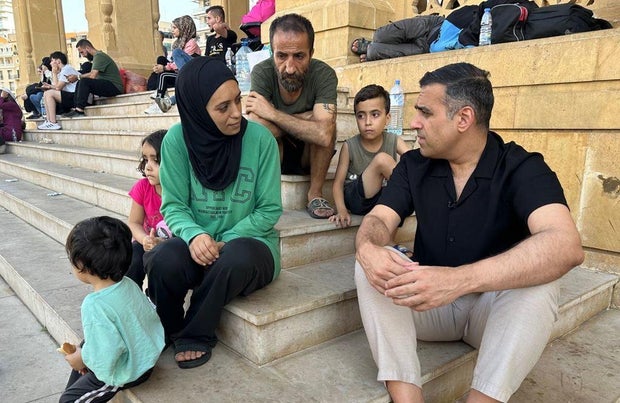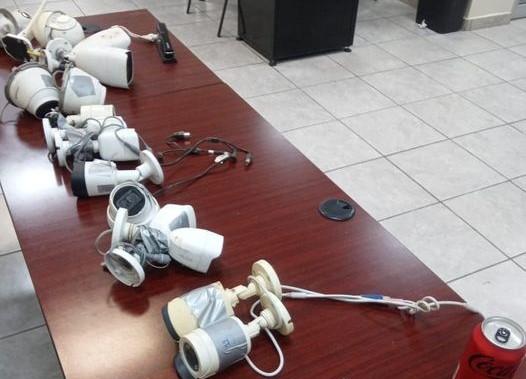CBS News
Hamas leader in Lebanon killed in airstrike as Israel says it killed a 7th Hezbollah commander

The Palestinian militant group Hamas said an Israeli airstrike Monday killed its leader in Lebanon.
Hamas said Fatah Sharif and his family were killed in the strike on the Al-Buss refugee camp in the southern port city of Tyre.
In the past week, Israel has frequently targeted Beirut’s southern suburbs, where Hezbollah has a strong presence – including a major strike on Friday that killed Hezbollah’s longtime leader, Hassan Nasrallah.
But on Monday, the first apparent Israeli airstrike on central Beirut in nearly a year of conflict leveled an apartment building.
Houssam Shbaro / Anadolu via Getty Images
It came after Israel hit targets across Lebanon in the past few days and killed dozens of people, with Hezbollah sustaining heavy blows to its command structure, including Nasrallah’s death.
Israeli officials had no immediate comment.
The airstrike hit in central Beirut a multistory residential building, according to an Associated Press journalist at the scene. Videos showed ambulances and a crowd gathered near the building in a mainly Sunni district with a busy thoroughfare lined with shops.
The airstrike killed at least one person and wounded 16, an official with Lebanese Civil Defense said, speaking on condition of anonymity because he wasn’t authorized to speak to the media. He said the person killed was a member of the al-Jamaa al-Islamiya, or the Islamic Group, a Sunni political and militant group allied with Hezbollah.
A Palestinian leftist faction in Lebanon said three of its members were killed in the airstrike. The Popular Front for the Liberation of Palestine said in a statement early Monday that its military and security commanders in Lebanon and a third member were killed in the attack.
Houssam Shbaro / Anadolu via Getty Images
Neither militant group has played a significant role in the ongoing conflict between Israel and the Shiite militant group Hezbollah.
Earlier, Hezbollah confirmed that Nabil Kaouk, the deputy head of its Central Council, was killed Saturday, making him the seventh senior Hezbollah leader killed in Israeli strikes in a little over a week. They include the group’s founding members who had evaded death or detention for decades.
Hezbollah also confirmed that Ali Karaki, another senior commander, died in the strike that killed Nasrallah. Israel says at least 20 other Hezbollah militants were killed, including one in charge of Nasrallah’s security detail.
The Lebanese Health Ministry said at least 105 people were killed around the country in airstrikes Sunday. Two strikes near the southern city of Sidon, about 28 miles south of Beirut, killed at least 32 people, the ministry said. Separately, Israeli strikes in the northern province of Baalbek Hermel killed 21 people and wounded at least 47.
Lebanese media reported dozens of strikes in the central, eastern and western Bekaa and in the south, besides strikes on Beirut. Israel says it targets militants, but the strikes have hit buildings where civilians were living and the death toll was expected to rise.
In a video of a strike in Sidon, verified by the AP, a building swayed before collapsing as neighbors filmed it. One TV station called on viewers to pray for a family caught under the rubble, posting their pictures, as rescuers failed to reach them. The Lebanese Health Ministry reported at least 14 medics were killed over two days in the south.
President Biden said Sunday he would speak soon with Israeli Prime Minister Benjamin Netanyahu and believes an all-out war in the Middle East must be avoided. “It has to be,” Mr. Biden told reporters at Dover Air Force Base in Delaware as he boarded Air Force One to head to Washington.
Biden says Nasrallah’s death is a “measure of justice”
On Saturday, Mr. Biden said Nasrallah‘s death in the Israeli airstrike was a “measure of justice” for his many victims.
In a statement released by the White House, Mr. Biden said. “Nasrallah and the terrorist group he led, Hezbollah, were responsible for killing hundreds of Americans over a four-decade reign of terror,” including thousands of Israelis and Lebanese civilians.
White House national security spokesman John Kirby said Sunday that Israel’s airstrikes in Lebanon had “wiped out” Hezbollah’s command structure, but he warned the group will work quickly to rebuild it.
“I think people are safer without him walking around,” Kirby said of Nasrallah. “But they will try to recover. We’re watching to see what they do to try to fill this leadership vacuum. It’s going to be tough. … Much of their command structure has now been wiped out.”
Speaking on CNN’s “State of the Union,” Kirby sidestepped questions about whether the Biden administration agrees with how the Israelis are targeting Hezbollah leaders. The White House continues to call on Israel and Hezbollah to agree to a 21-day temporary cease-fire floated by the U.S., France and other countries during the U.N. General Assembly last week.
Meanwhile, wreckage from Friday’s strike that killed Nasrallah was still smoldering. Smoke rose over the rubble as people flocked to the site, some to check on what was left of their homes and others to pay respects, pray or simply to see the destruction.
In response to the dramatic escalation in Israeli strikes on Lebanon, Hezbollah significantly increased its rocket attacks in the past week, from several dozen to several hundred daily, the Israeli military said. The attacks injured several people and caused damage, but most of the rockets and drones were intercepted by Israel’s air defense systems or fell in open areas.
The army says its strikes have degraded Hezbollah’s capabilities and the number of launches would be much higher if Hezbollah hadn’t been hit.
Israel says it hit Houthi targets
Also on Sunday, the Israeli military said dozens of its aircraft struck Houthi targets in Yemen in response to a recent attack. The military said it targeted power plants and sea port facilities in the city of Hodeida.
The Houthis launched a ballistic missile attack toward Israel’s Ben Gurion airport on Saturday when Netanyahu was arriving. The Houthi media office said the Israeli strikes hit the Hodeida and Rass Issa ports, along with two power plants in Hodeida city, a stronghold for the Iranian-backed rebels. The Houthi-run Health Ministry said the strikes killed four people and wounded 40 others.
The Houthis claimed they took precautionary measures ahead of the strikes, emptying oil stored in the ports, according to Nasruddin Ammer, deputy director of the Houthi media office. He said in a post on X that the strikes won’t stop the rebels’ attacks on shipping routes and on Israel.
A wave of Israeli airstrikes across large parts of Lebanon have killed more than 1,030 people – including 156 women and 87 children – in less than two weeks, according to Lebanon’s Health Ministry.
Hundreds of thousands of people have been driven from their homes. The government estimates around 250,000 are in shelters, with three to four times as many staying with friends or relatives, or camping out on the streets.
Hezbollah, a Lebanese militant group and political party backed by Iran, Israel’s chief regional rival, rose to regional prominence after fighting a devastating monthlong war with Israel in 2006 that ended in a draw.
Kaouk was a veteran member of Hezbollah going back to the 1980s and served as Hezbollah’s military commander in southern Lebanon during the 2006 war with Israel. The United States announced sanctions against him in 2020.
Hezbollah began firing rockets, missiles and drones into northern Israel after Hamas’ Oct. 7 attack out of Gaza triggered the war there. Hezbollah and Hamas are allies that consider themselves part of an Iran-backed “Axis of Resistance” against Israel.
The conflict has steadily ratcheted up to the brink of all-out war, raising fears of a region-wide conflagration.
Israel says it is determined to return some 60,000 of its citizens to communities in the north that were evacuated nearly a year ago. Hezbollah has said it will only halt its rocket fire if there is a cease-fire in Gaza, which has proven elusive despite months of indirect negotiations between Israel and Hamas led by the United States, Qatar and Egypt.
CBS News
Israeli strikes in Lebanon decapitate Hezbollah, but as civilian deaths mount, neither side backs down

Beirut, Lebanon — Israel expanded its airstrikes on Iran-backed groups in Lebanon and beyond over the weekend, launching raids thousands of miles away on Yemen’s Houthi rebels. The Israeli attack on Houthi targets in the Yemeni port city of Hodeida came after months of U.S. and British strikes against the group – a joint response to the rebels’ regular rocket, drone and missile attacks on international military and commercial vessels in the Red Sea.
The Israeli strikes also came, however, amid growing concern that Israel’s nearly-year-long war with the Houthi’s ideological allies Hamas in the Gaza Strip and Hezbollah in Lebanon could spiral into a broad regional conflict, drawing in Iran and even the U.S. to back their respective allies.
Israel hit the Houthis just a couple days after it assassinated Hezbollah’s longtime leader Hassan Nasrallah with a massive airstrike on Friday.
After that strike, Israeli forces continued pounding purported Hezbollah and Hamas targets across Lebanon’s south and east all weekend, but the southern Beirut suburb of Dahiyeh, the Hezbollah stronghold where Nasrallah was killed along with another senior commander and two other high-ranking members of the group, has borne the brunt.
Aziz Taher/REUTERS
The well-armed group’s surviving deputy leader Naim Qassem vowed Monday that Hezbollah would carry on – despite its near decapitation via airstrikes, and before that exploding pagers and walkie talkies – “facing the Israeli enemy to support Gaza and Palestine.”
He accused the U.S. of offering Israel “limitless support” for Israel to carry out “massacres” in Lebanon and Gaza, and then claimed Hezbollah had fired even more weapons at Israel, and deep into the country, since Nasrallah was killed.
But Hezbollah’s incessant drone and rocket fire is virtually wiped out by Israel’s advanced air defenses before it reaches any targets. There have been civilians injured over the last couple weeks, but in Lebanon’s capital, entire residential buildings have been flattened.
CBS News went to see the aftermath of one Israeli strike Sunday on the edge of Dahiyeh. A five-storey-building was reduced to rubble. It was still smoldering as another massive boom reverberated in the distance, underscoring the unpredictable security situation for Lebanese civilians as Israel carries on, determined, it says, to push Hezbollah many miles away from its border to stop the cross-border attacks.
Getty/iStockphoto
Israel has assassinated at least five Hezbollah commanders over the past week alone, and 19 in just a few months — dealing a major blow to the U.S.-designated terrorist group. Hezbollah ramped up its attacks on Israel a day after Israeli forces launched their first airstrikes on its Hamas allies, in immediate response to Hamas’ Oct. 7 massacre.
Hezbollah has acknowledged losing more than 30 operatives in recent weeks, including many of its senior leaders, but the ferocity and pace of the Israeli strikes in Lebanon has also taken a massive toll on Lebanese civilians. At least 1,000 people have been killed in just two weeks — 105 on Sunday alone.
According to Lebanon’s Prime Minister Najib Mikati, the strikes have displaced almost 1 million people from their homes, most of them fleeing southern Lebanon for Beirut of other locations further north.
Some of those displaced families — including many with young children — have come to Beirut’s iconic Blue Mosque, desperate to find safety. The place of worship has become a refuge for people who told CBS News they’d rather sleep in the courtyard’s surrounding the building, out in the open, than go back to their neighborhoods amid Israel’s bombardment.
Samar al-Attrash is among those who have found sanctuary outside the mosque. She fled her home in Dahiyeh with her husband and their three children, and little more than the clothes on their backs.
CBS News
“We have nowhere to go to but here,” the mother told us. “We are very scared and we can’t go back to Dahiyeh at all until the situation gets better.”
“I told my kids it’s scary and that we can’t go home,” she said. “I’m only telling [them] a little at a time so I don’t traumatize them.”
President Biden reiterated his warning on Sunday that an all-out regional war must be avoided, but as he spoke, CBS News correspondent Chris Livesay and his team reported that tanks and armored vehicles were massing on the Israeli side of the country’s northern border with Lebanon.
IDF handout
On Monday, Israeli Defense Minister Yoav Gallant paid another visit to Israeli troops waiting for orders near the border, telling them killing Nasrallah was, “an important step, but it is not the final one.”
“We will employ all of our capabilities,” Gallant told the Israeli troops, “and this includes you.”
It was the latest clear signal that Israel is preparing for some kind of ground operation in Lebanon — a move that has the potential to spark fighting even deadlier than anything seen since Oct. 7.
Despite the body blows dealt by Israel, Hezbollah’s deputy leader claimed Monday that the group’s “military capabilities are solid,” that it “will continue along the same path” it has been on for months – and that it is ready for a war with Israel.
contributed to this report.
CBS News
Tim Walz and JD Vance’s 2024 VP debate is tomorrow. Here’s what to know.

Washington — Sen. JD Vance of Ohio and Minnesota Gov. Tim Walz — both relative newcomers to the national political spotlight — face off Tuesday in the only scheduled vice-presidential debate before the November election.
The debate is being held three weeks after former President Donald Trump and Vice President Kamala Harris had their only scheduled debate.
Walz, who is Harris’ running mate, has had a long career in politics but was largely unknown to voters outside of Minnesota before he joined the Democratic ticket.
Vance, the author of “Hillbilly Elegy,” was first elected to office in 2022 — less than two years before being selected by Trump to be his running mate.
Here’s what to know about the debate.
What time will the VP debate start and end?
The debate starts at 9 p.m. ET on Tuesday. It will run 90 minutes — the same length as the two presidential debates — and end at 10:30 p.m. ET.
Who is moderating the VP debate?
“CBS Evening News” anchor and managing editor Norah O’Donnell and “Face the Nation” moderator and chief foreign affairs correspondent Margaret Brennan will moderate the debate.
Where is the VP debate?
The debate is taking place at the CBS Broadcast Center in New York City.
Trump was a lifelong resident of New York City, a Democratic stronghold, before changing his voter registration and primary residence in 2019 to Palm Beach, Florida, where his golf club Mar-a-Lago is located.
In 2020, Trump lost New York to President Biden by more than 20 points, but the former president insisted during a recent campaign event on Long Island that he could win the state this year.
“When I told some people in Washington, ‘I’m going up to New York, we’re doing a campaign speech,’ they said, ‘What do you mean New York? You can’t ever — nobody can win. Republicans can’t win. I said, ‘I can win New York, and we can win New York.’ We’re going to win,” Trump said.
What are the rules for the debate?
Both campaigns agreed to a 90-minute debate with two four-minute commercial breaks. Campaign staff are not allowed to interact with the candidates during the breaks.
There will be no audience — a measure also implemented during the two previous presidential debates.
At the event’s start, the moderators will introduce the candidates in order of incumbent party, with Walz coming first. There will be no opening statements.
Walz will stand behind the lectern on the left side of the stage, which will be on the right side of viewers’ screens. Vance will be at podium on the right side of the stage, but the left side of screens.
Candidates, who cannot bring pre-written notes or props on stage, will have two minutes to answer a question and two minutes to respond. They will be allowed one minute for rebuttals. At moderators’ discretion, candidates may get an additional minute to continue a discussion.
Unlike the presidential debates, a candidate’s microphone will not be muted when their opponent is speaking, but CBS News reserves the right to turn off the microphones.
Vance won a virtual coin toss on Thursday, opting to go second with his closing statement. Each candidate will have two minutes for their closing remarks.
No topics or questions will be shared with the campaigns in advance.
How can you watch the VP debate on cable?
CBS will air debate coverage starting at 8 p.m. ET on its broadcast stations and affiliates. Find your local station here.
Besides CBS, the debate will simulcast on a number of other broadcast and cable networks. Check your local listings.
How can you stream the VP debate without cable?
It will also be streamed on all platforms where CBS News 24/7 and Paramount+ are available, including CBSNews.com and YouTube.
Debate coverage on CBS News 24/7 begins at 4 p.m. ET.
CBS News
Surveillance cameras placed on palm trees by drug cartel “falcons” in city on border with Arizona, Mexico authorities say

Mexican authorities said they have detected and seized 24 drug cartel surveillance cameras fixed to telephone poles, light posts and even palm tree in the border city of San Luis Rio Colorado.
The city on the border with Arizona has suffered years of violence between drug cartels fighting for control of the border crossing, where they can smuggle drugs.
Prosecutors in northern Sonora state said Friday the cameras had been placed there by “falcons,” the name commonly used in Mexico for drug cartel lookouts seeking to keep tabs on the movements of soldiers and police.
Army troops removed the devices, and photos posted by prosecutors on social media suggested they were common porch-style cameras wrapped in duct tape. They were found in three different neighborhoods, located “on electric power poles, public lighting, telephones and even in palm trees,” prosecutors said.
Sonora State Prosecutor’s Office
San Luis Rio Colorado, located across from Yuma, Arizona, is best known as a border town where Americans go for inexpensive prescriptions and dental work. But it has increasingly been hit by drug cartel violence.
It is not the first border city where cartels have installed their own surveillance networks.
In 2015, a drug cartel in the northern state of Tamaulipas used at least 39 surveillance cameras to monitor the comings and goings of authorities in the city of Reynosa across the border from McAllen, Texas.
The cameras were powered by electric lines above the city streets and accessed the internet through phone cables along the same poles, and included modems and were capable of operating wirelessly or through commercial providers’ lines.
Several of the cameras were trained on an army base, while others captured movement outside a marine post, offices of the attorney general and state police as well as shopping centers, major thoroughfares and some neighborhoods.
Over the course of 2015, authorities also discovered 55 radio communication antennas between the nearby border cities of Matamoros and Miguel Aleman.
Last week, the U.S. Treasury Department said it sanctioned two Mexican businesses — an ice cream chain and a local pharmacy — for allegedly using proceeds of fentanyl trafficking to finance their operations tied to the Sinaloa cartel.
The sanctions were announced as rival cartel factions have been in a deadly conflict with each other and authorities following the surprise arrest on U.S. soil of Sinaloa Cartel co-founder Ismael “El Mayo” Zambada in late July, which is believed to have unleashed an internal power struggle within the group.



